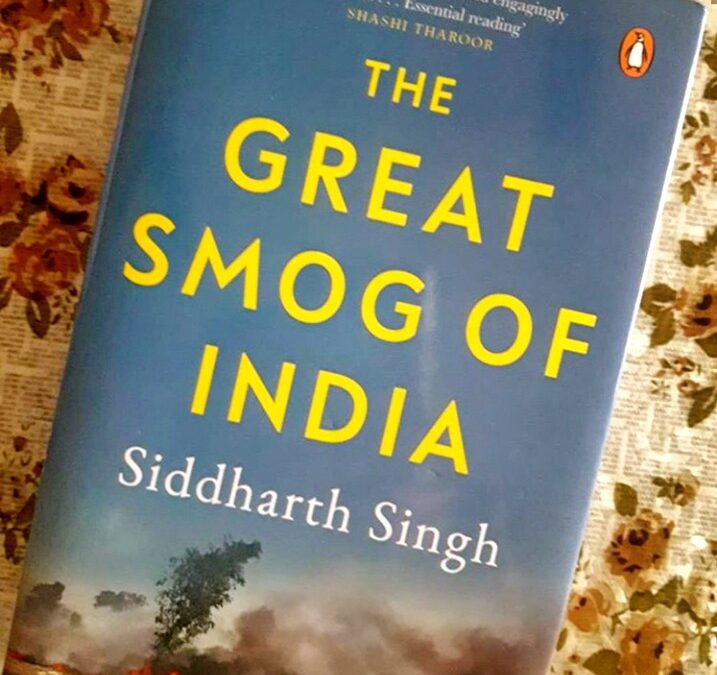The Great Indian Smog — Siddharth Singh
Publisher: Penguin Viking
Pages: 272
Price: Rs. 499 INR(Hardcover), Rs. 445 (Kindle Edition)
ISBN: 978–0670091171
Buy here: https://amzn.to/2NC16UQ
Air pollution kills over a million Indians every year, albeit silently. Families are thrown into a spiraling cycle of hospital visits, critically poor health and financial trouble impacting their productivity and ability to participate in the economy. Children born in regions of high air pollution are shown to have irreversibly reduced lung function and cognitive abilities that affects their incomes for years to come. They all suffer, silently.
The issue is exacerbated every winter, when the Great Smog of India descends and envelops much of northern India. In this period, the health impact from mere breathing is akin to smoking a pack of cigarettes a day. The crisis is so grave that it warrants emergency health advisories forbidding people from stepping out. And yet, for most of us, life is business as usual.
It isn’t that the scientific community and policymakers don’t know what causes air pollution, or what it will take to tackle the problem. It is that the problem is social and political as much as it is technological, and human problems are often harder to overcome than scientific ones. Each sector of the economy that needs reform has its underlying political, economic and social dynamics that need to be addressed to make a credible impact on emissions.
With clarity and compelling arguments, and with a dash of irony, Siddharth Singh demystifies the issue: where we are, how we got here, and what we can do now. He discusses not only developments in sectors like transport, industry and energy production that silently contribute to air pollution, but also the ‘agricultural shock’ to air quality triggered by crop burning in northern India every winter. He places the air pollution crisis in the context of India’s meteorological conditions and also climate change. Above all, and most alarmingly, he makes clear what the repercussions will be if we remain apathetic.
About the author:
Siddharth Singh is an energy, mobility and climate policy expert. He was selected to be a German Chancellor Fellow in 2016–17 under the guardianship of Chancellor Angela Merkel’s office. In the past, he has worked at the Wuppertal Institute in Berlin, Fridtjof Nansen Institute in Oslo and TERI in New Delhi. He has a graduate degree in international studies and diplomacy from SOAS, University of London, and an undergraduate degree in economics from the University of Delhi. The Great Smog of India is his first book.
My take on the book:
For the past few years, every winter, India, especially the northern states, go through a heavy smog influence. While Delhi stands at the top of the list with the worst air quality, most of the northern states are no exception to this issue. The severity has only been increasing with each passing year, however, governments, and the population at large have only been going through this rather than taking serious steps to minimize it. This book is a comprehensive account of smog, its effects on human life, economy, and the various factors that contribute to smog.
The writer starts with the major factors causing smog and how the population living in these cities knowingly/unknowingly are exposed to it and hence the health risks faced by them. This in turn effects the economy, the sectors like public health and their inability to cater to the growing needs, quality of life of the residents and how the various sectors of the society are involved in this vicious cycle. The writer observes how this serious problem is interestingly not a point of discussion or agenda for any political parties during their election campaigns.
The writer then goes onto explain in detail the various factors like geographical disadvantage faced by some of these cities. Like how Chennai also is a hub for extreme industrial pollutants but the sea winds help in carrying away these particles. Cities like Delhi which lack a sea to carry away the pollutants also have added disadvantages like dust getting carried over from the Thar desert.
The next sections are dedicated to the forms and sources of energy generation and hence the resulting pollution, industrial wastes, pollution from automobiles, debate about public transport and the different fuels used by citizens, the habit of crop burning in states like Punjab which generally coincides with the winter months resulting in non-movement of the generated smoke. The next two sections gives detailed in sight into how the administration is handling this grave problem and how policy making is not helping the real cause. The writer concludes with how general public need to react and respond to this smog issue and what can be done starting from smaller to larger scales with respect to citizen responsibility.
The author has done in depth and extensive research around the subject and provides ample data and statistics to support all his arguments. The book is comprehensive, educative and stresses the need to understand and act on this issue before the situation goes further out-of-control.This book is a must-must read for all the citizens of India, to know the smog situation and the compelling reasons behind it, beyond what the news headlines speak about.
My rating:
5/5.

Aakanksha
Nice review 😊
kiranmayi
Thanks!